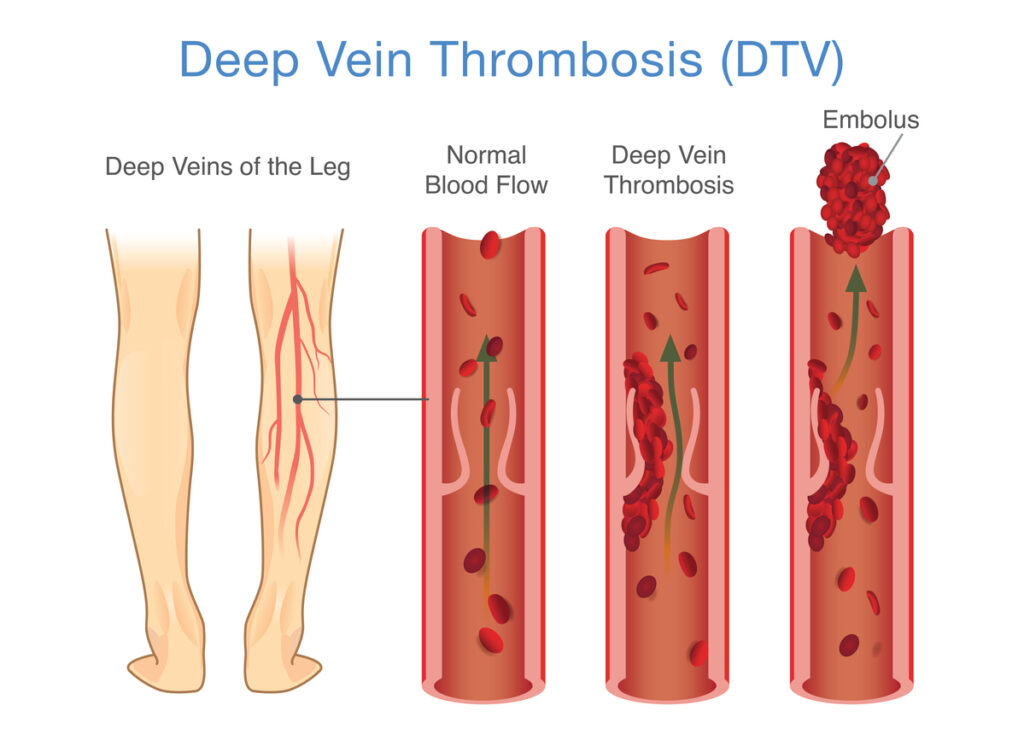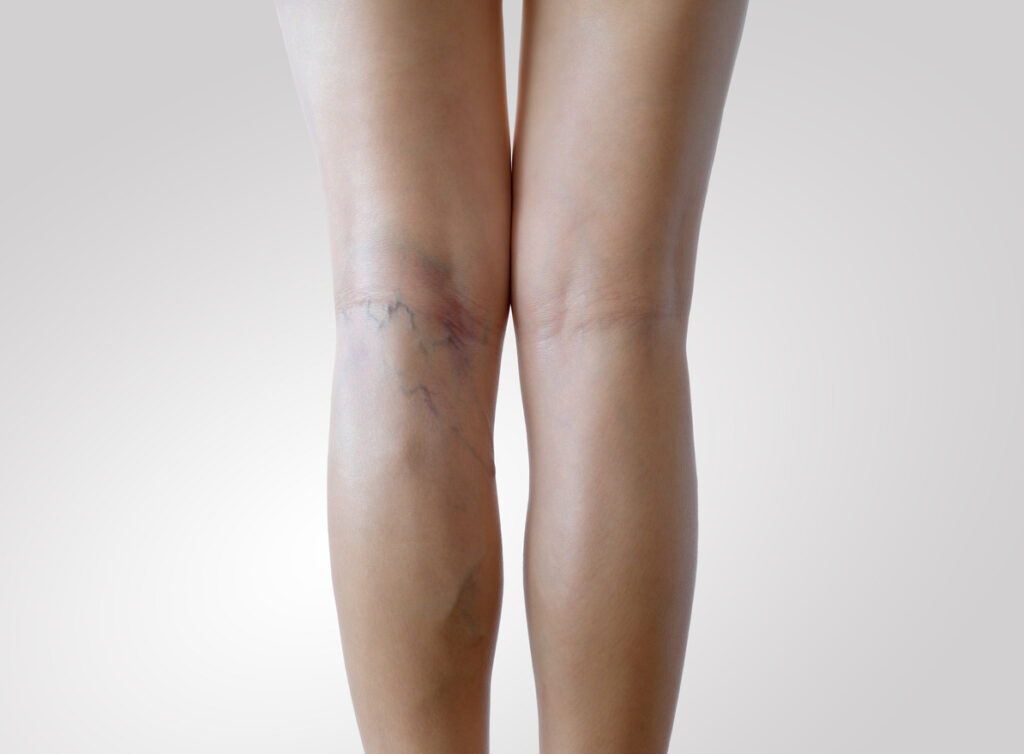Deep vein thrombosis vs varicose veins – these are both common conditions that affect the leg veins but they differ a lot in terms of their causes, symptoms, possible complications and treatment.
What is deep vein thrombosis vs varicose veins?
Deep vein thrombosis (DVT) is where a blood clot forms in a deep vein, most often in the legs or within the veins in the pelvis. It is a more serious condition than varicose veins because the clot can break away and travel to the lungs and cause a pulmonary embolism (PE), which can be life-threatening. A DVT may lead to post-thrombotic syndrome (PTS) in the legs, causing long-term swelling, pain, discolouration of the skin, infections (cellulitis), and ulcers.

Causes of DVT include long periods of sitting and not moving, which is why we recommend doing seat exercises and walking when travelling long distance. Other causes are surgery, which is why patients are fitted with compression stockings after, as compression stockings help keep blood flowing. As well, some medicines, smoking and medical conditions, such as cancer and genetic disorders that affect blood clotting, may also cause DVTs.
What are varicose veins?
Varicose veins – swollen, ropey-looking veins. Mostly seen just under the surface of the skin. Most often in the legs. The main cause of varicose veins is the weakening of vein walls and valves, leading to poor blood flow back to the heart and pooling of blood in the legs. The most common factor in the development of varicose veins is family history or genetics. For those people with a tendency to form varicose veins, other factors such as pregnancy, standing jobs and obesity are also important.
What are the main symptoms of deep vein thrombosis vs varicose veins?
Symptoms of DVT:
- Swelling in one leg
- Pain or tenderness in the area, especially when walking or standing
- Bluish discolouration in a leg.
Symptoms of varicose veins:
- Visible veins – blue or purple and lie just under the skin
- Veins that bulge or are twisted
- Aching or pain, especially after long times standing
- Swelling in the legs or ankles
- Itching around the veins
- Cramping in the legs at night
- A feeling of heaviness in the legs.
How is DVT diagnosed? What are the treatment options?
Diagnosis of DVT involves an ultrasound and consultation with a vascular specialist. Treatment generally includes anticoagulant medicine to prevent a clot from growing and management by wearing compression socks to keep blood flowing. In some cases, surgery by a vascular specialist to remove the clot (thrombectomy) will be needed.
How are varicose veins diagnosed? What are the treatment options?
For diagnosis of varicose veins we ask you fill in our consultation form, adding photos, and our nurse will be in touch. Before treatment our vein specialist will do an ultrasound scan to confirm varicose veins and to assess blood flow.
Treatment options vary depending on whether you have varicose veins, spider veins or smaller veins. The vein specialist may recommend wearing compression socks to help improve blood flow, sclerotherapy for smaller varicose veins or minimally invasive varicose vein treatment. Varicose vein treatment can be performed using sealing techniques (Venaseal) or heating techniques (radio frequency or internal vein laser). All of these techniques are equally effective based on many scientific studies. The sealing technique (Venaseal) involves a medical sealant that combines with your blood to make it sticky enough to seal the vein. Radiofrequency and laser techniques cauterise (heat) the vein from the inside, causing it to seal off.

Can you leave your DVT untreated?
No. Almost all DVTs require treatment with blood thinners. A DVT can be life-threatening if it breaks away and travels to the lungs causing a pulmonary embolism (PE). If you suspect a DVT you can also complete our consultation form. We recommend seeing a vein specialist at one of our vein clinics for diagnosis.
Can you leave your varicose veins untreated?
Once your vein is varicose it is no longer transporting blood to the heart. When more noticeable, and if you have any of the symptoms above, talk to your general practitioner (GP) or vein specialist. Untreated varicose veins may cause more symptoms, such as aching, throbbing, itching, burning and cramps. Sometimes, when they are more advanced, they may cause leg ulcers, skin infections (cellulitis) and they may bleed. All of these conditions then require more intensive treatment.


